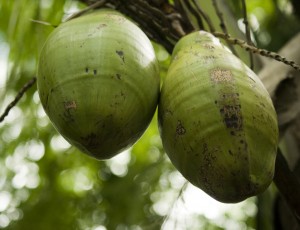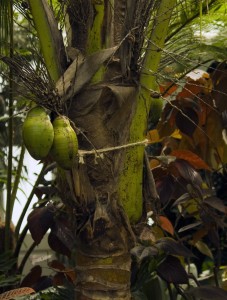Globetrotting with Coconuts
Posted in Around the Garden, Gardens and Collections, Learning Experiences on April 8 2012, by Matt Newman
 Under the glass of the Enid A. Haupt Conservatory‘s Palm House grows an iconic tree, commonplace to most tourists of the tropics. In the wild, the fruit dangles in lumpy clusters from a familiar silhouette, bending like an elbow toward the sea, a thin pole with a spray of long green leaves at the peak. Visit any beachside farmer’s market in the islands of the Caribbean and you may see the ubiquitous coconut held out in the hands of stall hawkers, a straw stuck through a bored-out husk for passersby to taste.
Under the glass of the Enid A. Haupt Conservatory‘s Palm House grows an iconic tree, commonplace to most tourists of the tropics. In the wild, the fruit dangles in lumpy clusters from a familiar silhouette, bending like an elbow toward the sea, a thin pole with a spray of long green leaves at the peak. Visit any beachside farmer’s market in the islands of the Caribbean and you may see the ubiquitous coconut held out in the hands of stall hawkers, a straw stuck through a bored-out husk for passersby to taste.
But beyond the frosty lip of a piña colada glass, the coconut earns a mixed reputation in the culinary circuit. It clutters cake frosting, makes an appearance in the occasional creme pie, lurks in the most innocuous-looking candy bars–yet how many people do you know who go gaga for the pulpy flesh of this tropical mainstay? I defer to a readily available explanation for the widespread dislike: “It’s not the taste, it’s the consistency.” And with that, I will never again have an opportunity to quote Zombieland, much less Woody Harrelson.
Thankfully for those without a tooth for the fruit, the coconut (Cocos nucifera) has more going for it than its edible insides. It’s a veritable jack of all trades in the plant world. And through thousands of years of human civilization, it’s been doing its part as a workhorse crop, feeding, hydrating, clothing, and tooling the people who live with it.
Most are already familiar with the edible meat (or “copra”) of the kernel–that hard, woody shell that hangs out inside the green husk; the white flesh that you scrape out with a spoon is also dried and crushed to produce coconut oil for cooking and cosmetics. Younger fruit creates coconut water, which, as I hear it, is the latest health fad among celebrities (lots of electrolytes to be had, though beware of its tendency to serve as a natural laxative should you imbibe nothing but). However, when sufficiently mature, the liquid is replaced by a solid core of coconut meat.
 The fibers of the husk, known as coir, are useful in crafting rope or coarse fabrics. In turn, the dense coconut shell can be carved into a slew of household utensils or baubles–spoons, buttons, and cocktail cups awaiting garish paper umbrellas. You can even get on Etsy at this very moment, stumble your way through a brief search, and come up with at least a few fully-functional teapots made from polished coconut shells.
The fibers of the husk, known as coir, are useful in crafting rope or coarse fabrics. In turn, the dense coconut shell can be carved into a slew of household utensils or baubles–spoons, buttons, and cocktail cups awaiting garish paper umbrellas. You can even get on Etsy at this very moment, stumble your way through a brief search, and come up with at least a few fully-functional teapots made from polished coconut shells.
Not only that, but the palm tree itself is useful in many ways–the leaves can be fashioned into various functional objects, from clothing to roof thatching. “All-purpose” is nearly a literal term when it comes to the coconut.
An ancient point of origin, however, is slightly more difficult to work out than the plant’s uses. The coconut is notorious for its traveling habit. Its penchant for “escaping” native territory and pioneering new growth on barren islands–often long distances from its parent plant–makes it a global citizen (so long as you stick to its twenty degree range north or south of the equator). This is thanks to the survivability of the thick, green husk of the fruit, which–after dropping into the ocean–can float along for three or four months in saltwater and still germinate the seed upon washing ashore. This sometimes happens hundreds (if not thousands) of miles from where the seven- or eight-pound fruit first falls from the tree. To this end, there’s little agreement on where and when the coconut first found purchase–even the fossil records can’t provide a solid conclusion between Australia, India, Southeast Asia, or South America.
It’s made even more difficult because, according to Frederic Rosengarten, Jr. and the International Palm Society, the coconut has been making the rounds of world trade for centuries. After being described by an itinerant Egyptian monk in 545 A.D., and again in 1280 by Marco Polo, “coconut” made its way into general English usage through 16th century Spaniards and Portuguese. The Iberian peninsula crowd in turn planted coconut palms in the Caribbean and South America, while Polynesians carried it throughout the Pacific as a portable source of food and water. By hand and by sea, the coconut soon became pantropical.
As a funny aside, anyone who’s spent time in south Florida will know that coconut palms spring up everywhere. But they’re not at all native. It so happens that an existing collection of Trinidadian Cocos nucifera that was growing in the mid-19th century got a shot in the arm when a ship laden with coconuts wrecked on a nearby beach. That was in 1878. And by 1900, the subtropical tip of Florida was home to over 300,000 coconut palms.
But regardless of where it first claimed native country, the coconut remains a major player in global agriculture, as it has been for several centuries. It’s estimated that for each and every person on Earth, at least eight coconuts are grown per year, and that’s without a care for whether or not you enjoy the taste. So the next time you cook up a Filipino dish, put on moisturizer, or sort your way through a pile of packaged Snoballs in the local convenience store, give a thought to the fact that it probably started with a clunky fruit hanging high above the sand. Or, in our case, high above the floor of the Enid A. Haupt Conservatory.
According to Francisca Coelho, our VP for Glasshouses and Exhibitions the coconut palm we planted in 1996 is just now fruiting. These are some of the only successfully glasshouse coconuts she’s seen in a cold-weather location like New York. That said, be sure to pay our coconuts a visit when you stop in for the Orchid Show–even in a controlled environment, the spring weather seems to agree with them, and they’re a rare sight in a place like this.

